Pipedrive vs. Trello: Which Board Tool is the Best?

Sorry, there were no results found for “”
Sorry, there were no results found for “”
Sorry, there were no results found for “”
Customer relationship management (CRM) is an essential area to master if you’re looking for overall business growth. According to a survey by Stella Connect, 50% of consumers prioritize customer service when choosing between brands.
Most managers would agree that Kanban boards are the secret to visualizing and managing CRM workflows, customers, and leads across different stages in a sales pipeline. Pipedrive and Trello are two top-rated Kanban-style tools available, but is one better than the other?
At first glance, they’re pretty similar—the drag-and-drop design, hundreds of integrations, and robust task management options can jumpstart your team’s efficiency. But dig deeper, and you’ll see that both tools serve unique purposes for marketing and sales teams.
We’ll put on our unbiased detective hats and take you on a Pipedrive vs. Trello journey. Go through our extensive feature comparison and determine the project management software winner.
And who knows, you may spot a superstar alternative that could cater to all your CRM and project management software needs along the way. ⭐
Pipedrive is a popular cloud-based CRM tool focusing on sales. It packs a punch with features for visualizing, customizing, and managing sales pipelines, enhancing customer experience, and boosting team collaboration. 😍
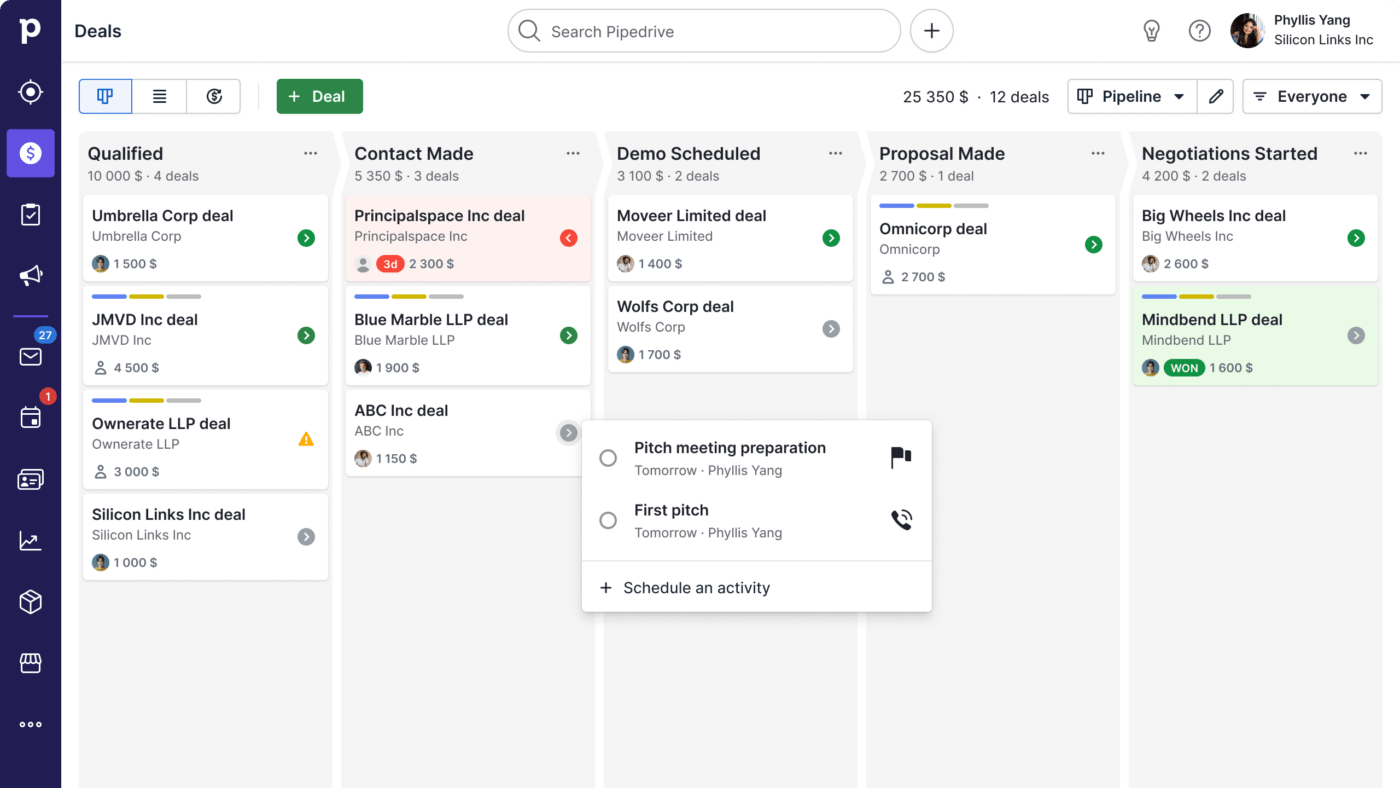
Pipedrive loves Kanban boards—it allows you to create customized pipeline boards and represent each stage as cards (or deals) movable with simple drag-and-drop actions. Use them to outline steps to sales and track customer journeys through different statuses.
The CRM wizard has excellent lead filtering and segmenting options, and a single overview of your board will reveal where you stand with different prospects in the sales pipeline. Easily track projects in its calendar view, which also allows users to best use Pipedrive as a true collaboration tool.
With this powerful tool, you can create personalized experiences for your customers. Task automation, an AI-powered sales assistant, lead generation features, email marketing, and chatbots are only some of the options that make your workflows more efficient and save you time.
What makes Pipedrive so popular? Let’s check out its most notable features.
If you ask salespeople why they love Pipedrive, we bet many would start praising its sales automation options. The tool recognizes the challenges salespeople face, like tedious administration, lead management, and forecasting the sales pipeline. But this tool helps overcome them with robust automation features (available on Advanced and higher plans).
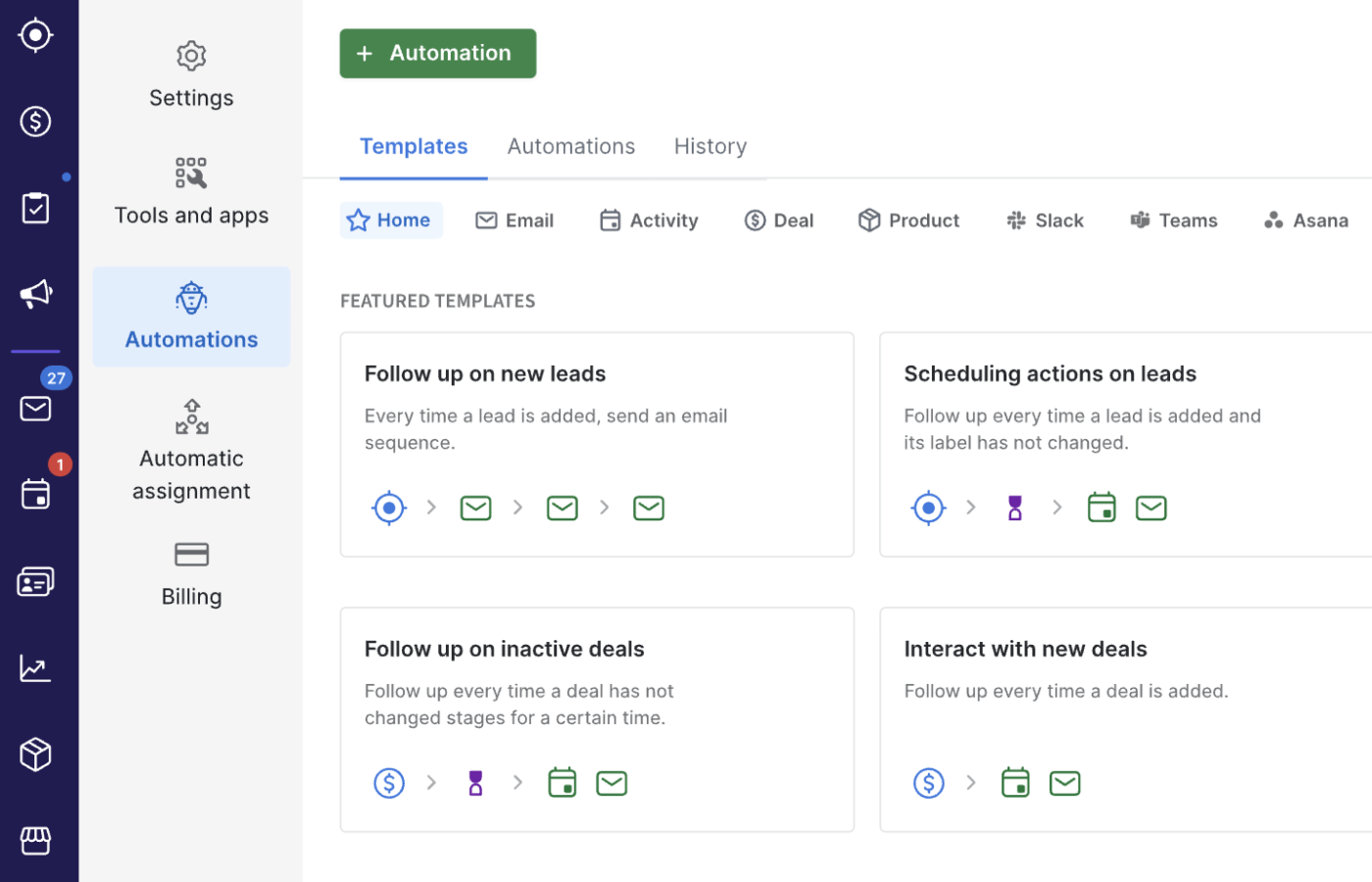
You can automate virtually any part of the sales process. Send personalized emails to leads, follow up on inactive deals, move deals through the pipeline, and forecast revenue in only a few clicks. Pipedrive lets you customize your own automations with trigger and action events. You can even access pre-made workflow automation templates to make the process easier!
Every CRM tool has reporting options, so why is this Pipedrive’s prominent feature? Well, the platform takes a step further and allows you to understand and nurture relationships with your customers and leverage the info to grow your business.
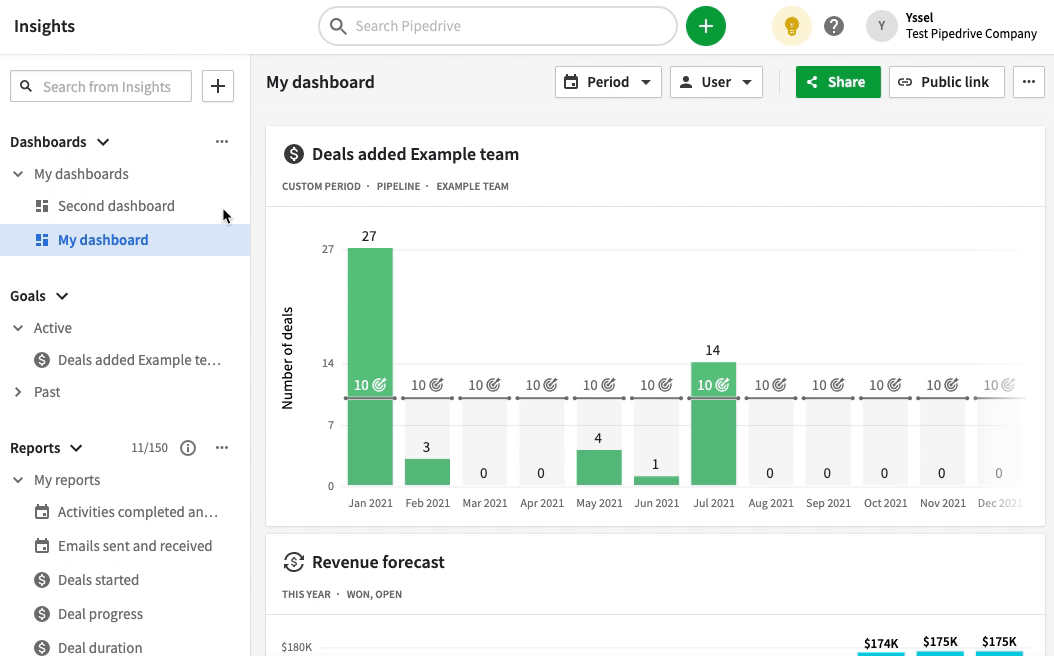
The tool has a unique Insights dashboard to help you identify customer trends through a bunch of visually packed reports. With the available metrics and charts, you can recognize bottlenecks and identify winning patterns for marketing campaigns.
The tool’s reporting options are especially handy when planning sales and CRM strategies. With business intelligence data about deal velocity and revenue targets, you can make accurate predictions and informed decisions on how to move ahead. 💯
Pipedrive lets you equip your company with CRM superpowers thanks to add-ons designed to boost productivity, collaboration, and workflow management.
A popular add-on is LeadBooster—it lets you capture and engage leads with chatbot assistance, live chat, and web forms.
If you want to see how visitors interact with your website, use the Web Visitors add-on. It displays who visits your website, how long they stay on, and what they engage with the most.
Another valuable add-on is Smart Docs, a centralized hub for managing documents like proposals, quotes, and contracts.
*All listed prices refer to the yearly billing model

Trello is all about the board view. This project management platform utilizes Kanban boards as its main interface to manage Trello cards. The platform helps you create and manage workflows, coordinate teams, and ensure every project is completed on time with minimal hiccups.
The best thing about Trello is its versatility—with minor adjustments, project management tools like this can become a powerful CRM hub. In addition, Trello is suitable across industries, be it finance, health and wellness, and nonprofits.
The platform is all about saving time. With Butler, Trello’s built-in automation tool, you can set rules and ensure no task falls through the cracks. Set triggers and desired actions, and watch Trello do the heavy lifting for you while you focus on something else. Butler can even spot repetitive processes and suggest available automations.
The platform’s drag-and-drop design ensures smooth sailing through Kanban boards and makes task management a breeze.
Trello brings several CRM-friendly capabilities to the table. Let’s check out some noteworthy features.
The three magic words Trello lives by are boards, lists, and cards. They help you get a clear overview of your projects and track team workloads and progress.
Trello boards serve as the home for every live project. This is where you add and sort tasks and move things around to keep your space current and clutter-free.
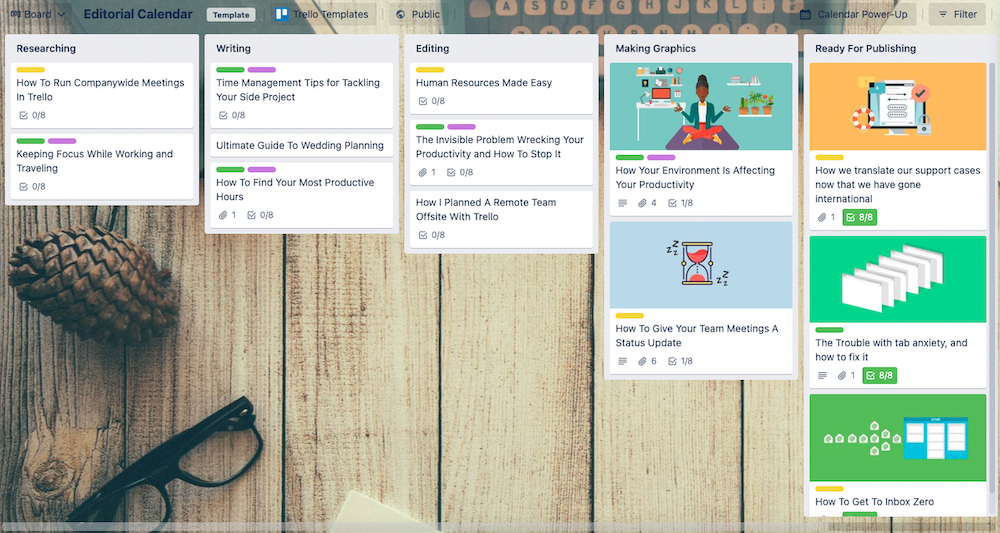
Every Trello board contains lists representing different stages of your tasks, such as To-Do, Doing, In Review, and Done to better manage projects. Lists give you a quick overview of a project’s progress, helping you prioritize and customize workflows.
Cards represent singular tasks, expanding on details like the assignee, due date, description, and attachments. Sort your cards through lists by dragging and dropping and ensure flawless organization.
A change of perspective can help you spot task risks and inefficiencies and come up with ways to optimize your project management processes.
Trello makes this possible with multiple project views—seven, to be precise. The tool is known for its Board view, a Kanban-style view displaying your entire project-related tasks as cards, but Trello users also enjoy other layouts.
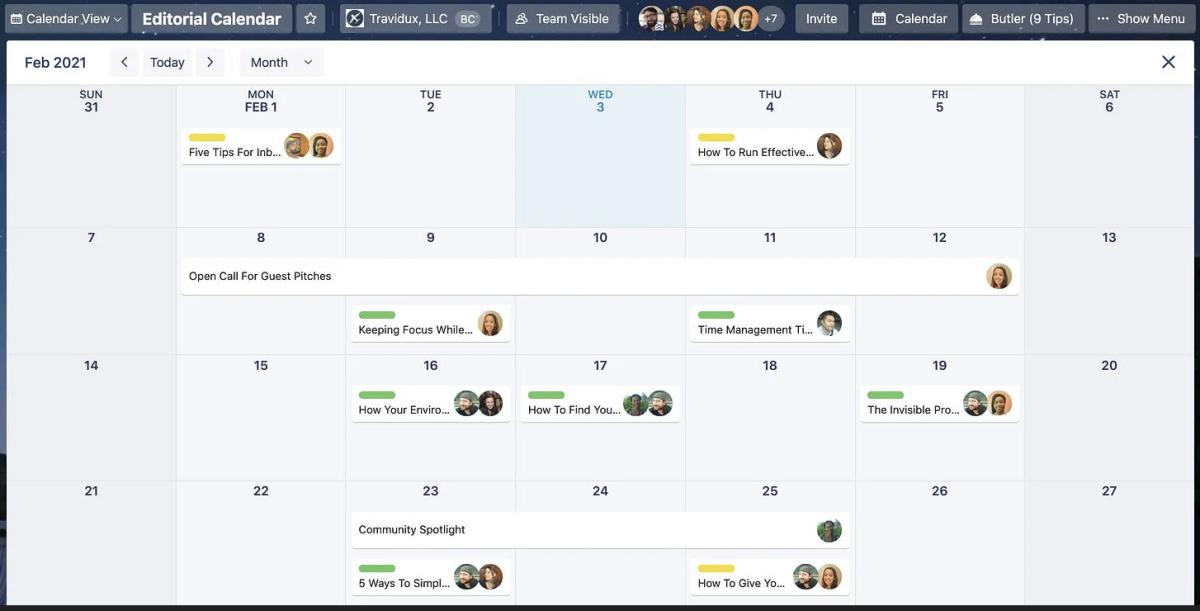
For example, you have the Calendar and Timeline views to visualize due dates, schedules, and workloads. Play with different data points on the Dashboard view and analyze cards per due date, team member, list, or label.
Trello offers hundreds of premade templates to help you and your team reach the stars! For your convenience, the platform sorts templates into multiple categories.
Use Project management templates to build workflows, keep track of meetings, organize pending tasks, and mark tasks as Done for the ultimate feeling of success! 😌
Explore Trello’s set of Sales templates to find CRM-focused options. For instance, use the CRM Pipeline Template to sort leads, manage contact information, and centralize resources to allow users to navigate pipelines. The Customer Success Board is another solid template with granular views of each customer account.
*All listed prices refer to the yearly billing model
Both Pipedrive and Trello are handy tools leveraging Kanban boards to bring efficiency to your workflows, organize processes, and facilitate collaboration. That said, the two tools differ in many important aspects, primarily their core use. Pipedrive is a Kanban board CRM expert focusing on sales, while Trello is a project management tool—allowing users to drag and drop cards for quicker workflows.
Still, their uses overlap to some degree—Pipedrive has some PM capabilities, and Trello can be used as a CRM platform. Let’s throw a three-round Pipedrive vs. Trello match and see which tool comes out as the winner! 🥇
Both contestants hold up well in this area with impressive automation features for if-then scenarios. Pipedrive is sales-focused, so most automation options revolve around generating and assigning leads and expediting admin work like storing contacts. It currently offers 36 premade automation templates.
Trello offers more generalized automation options to keep your Kanban boards clutter-free. Its Butler feature may give it an advantage over Pipedrive. Butler supports no-code automation with handy commands and a rich menu, even suggesting quick-add automations for repetitive tasks.
This is incredibly convenient for beginners struggling to identify what to automate or how.
All in all, both tools are first-rate at the automation game, but Trello may have the upper hand here because of its dedicated Butler tool.
Teamwork and transparent communication are vital for every company, and both Pipedrive and Trello developers are well aware of that. With that in mind, these platforms allow you to leave comments, ask questions, and work in real-time with your coworkers, regardless of location.
The difference? Pipedrive has more robust external, CRM-oriented communication options. Pipedrive lets you check up on your clients and follow up on your leads in a few clicks.
Being a PM tool, Trello focuses more on internal communication—you can leave comments on task cards, use mentions, and take notes. The platform even has templates that streamline collaboration. For example, the Collaboration Board helps you prioritize and discuss projects with your coworkers in a more informal setting in Pipedrive.
While both products support remote teams, Pipedrive may appeal to you more in terms of sales-enabling communication tools like email marketing and tracking. 📧
Integrations with other work tools can extend any platform’s functionality, so it’s no surprise both Pipedrive and Trello offer plenty of options.
In terms of the number of integrations, Pipedrive takes the win—it offers 400+ integrations, while Trello falls behind with 190+.
As Pipedrive is more sales-oriented, it offers integrations with platforms for email marketing, lead generation, proposals and contracts, and accounting and invoicing.
Trello has a palette of more general integrations for use cases like:
While the ball is in Pipedrive’s court when it comes to the number of integrations, we’d say it’s a tie. That’s because Trello is a subsidiary of the software giant Atlassian and integrates seamlessly with sister products like Jira and Confluence.
The tech-savvy Reddit crowd enjoys great credibility when it comes to software discussions. We checked out some threads to see how Redditors feel about Pipedrive and Trello as CRM tools.
For the most part, users believe Pipedrive is a decent CRM tool for small businesses. Here’s an extract of a thread:
“Works quite well for SME B2B companies, but IMO doesn’t allow as much for scalable growth. Restricted in terms of permission settings and the amount of features you can automate.”
Some users think that Trello is an okay CRM option, even though that’s not its primary purpose:
“Trello is never recommended as a CRM and that’s understandable since it is not advertised for that. Still I think it works great as a CRM using the premium version where custom fields can be added, then keeping a simple kanban view of New leads > contacted leads > hot leads > closed/lost.”
Another thread says:
“I wish Trello could somehow be easily turned into a CRM. It would be great. But so far I don’t see it that way..”
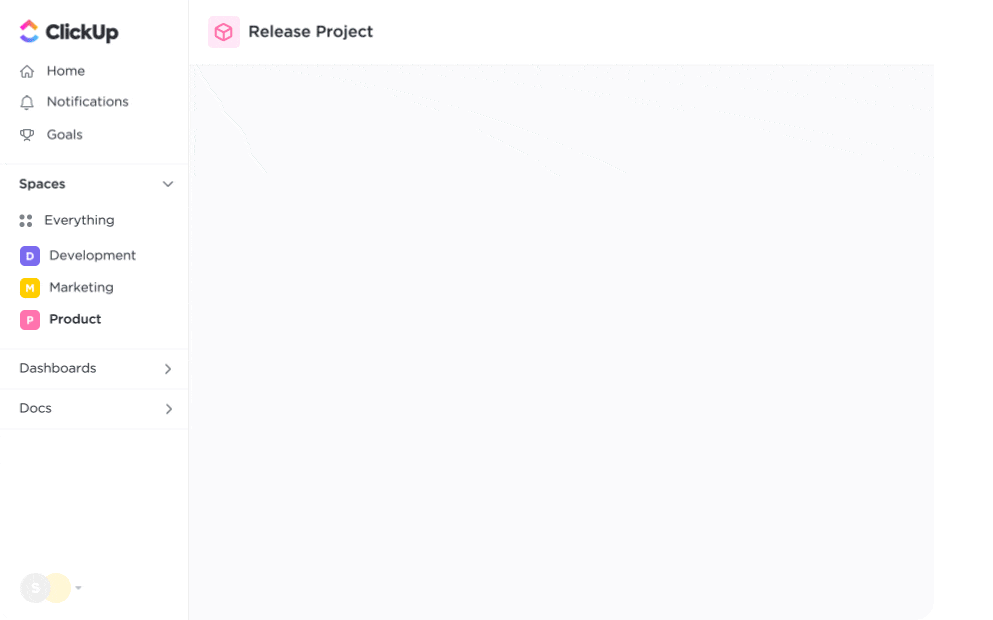
When choosing between Pipedrive and Trello, you’re essentially making a compromise. One is perfect for sales-oriented CRM but lacks advanced PM options, while the other is a PM powerhouse but not the best option for managing customers.
What if we tell you you don’t have to compromise? You can get the best of both worlds with ClickUp, an all-in-one tool that helps your company thrive with high-end PM and CRM functionalities.
From managing leads and nurturing relationships with existing customers to handling internal communication and projects of all types and sizes, ClickUp can transform your processes.
Here’s a sneak peek of the remarkable features that make ClickUp an excellent Pipedrive and Trello alternative.
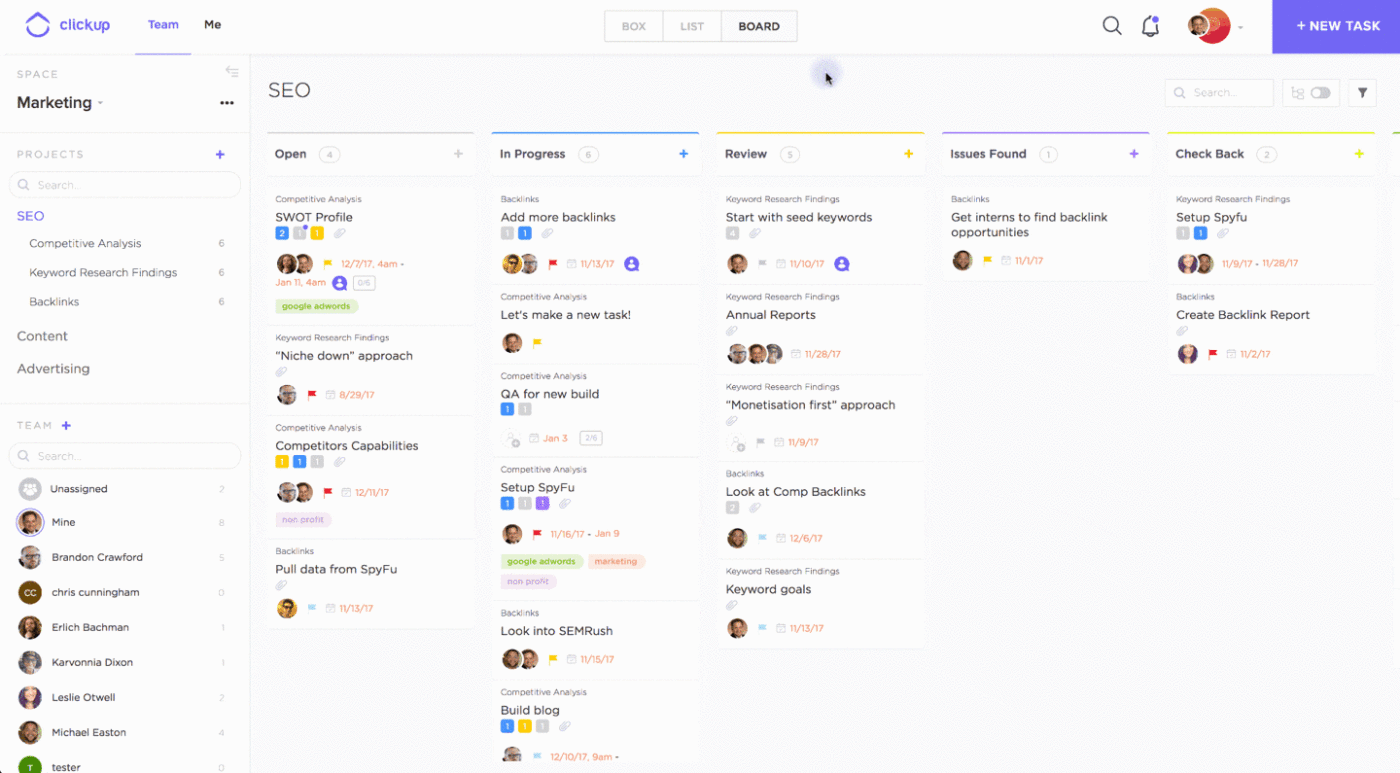
ClickUp offers 15+ project views, one of which is all about Kanban-style cards. With ClickUp Kanban boards, you can manage sales pipelines and sort potential and existing customers into customizable categories. Break up exhausting projects into manageable task cards and represent them based on their status, due date, or another criterion you choose.
ClickUp Kanban boards are easy to use, thanks to the drag-and-drop interface for moving cards along lists. Create multiple customized pipelines with stages like Contacted, Interested, Negotiating, and Deal Closed. Add task assignees, set priorities and due dates, and sort and filter through your workflows.
Handling multiple boards? Use the Everything view to get a centralized bird’s-eye overview of all your Kanban boards.
Editing multiple tasks can be tedious, so ClickUp came up with the Bulk Action Toolbar. Use it to update several tasks at once without leaving your board. With ClickUp Automations, you can automate all kinds of busywork, including assigning tasks based on lead position, updating statuses, and sending emails to prospects. Select from 100+ routine options or create your own.
Kanban boards are collaboration-friendly and also supported on the ClickUp mobile app. Just add your team to the boards and collaborate using mentions, commend threads, digital whiteboards, and proofing, among other tools.

ClickUp is like a chameleon—it adapts to different business demands. Want to use it for its robust project management features? That’s fine! But if you’re looking for a comprehensive CRM suite, ClickUp definitely delivers. ✌️
ClickUp CRM is all about accelerating customer growth and satisfaction through tailored pipeline and account management. Its bundled features are suitable for startups and large enterprises alike.
You can explore multiple flexible views to monitor hot leads, accounts, orders, invoices, and customer journeys. Capture customer data using tailor-made ClickUp Forms and use Custom Fields to manage contact info.

Turn to Dashboards with 50+ widgets and reporting tools to analyze customer data and gain valuable insights into the processes that work well and the ones that can be improved.
Try ClickUp’s impressive email management options to follow up on leads, send project info to customers, and collaborate with ease. Integrate with 1,000+ work tools to streamline everyday processes.
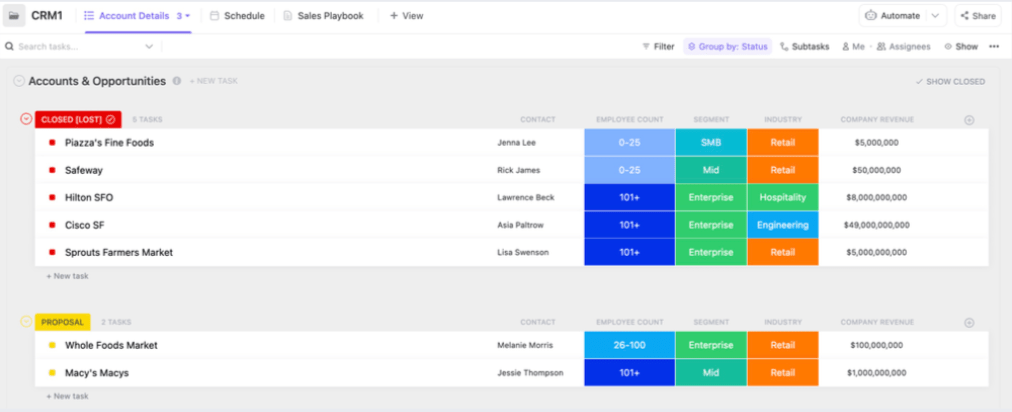
ClickUp offers 1,000+ templates for various purposes. Choose from a selection of Kanban board and customer management templates to keep your team moving. For all-in-one pipeline management, there’s one you shouldn’t hesitate to try: the ClickUp CRM Template.
This template is a centralized hub for everything related to pipelines and customer relationships. It offers multiple expert-designed views for organizing info.
For example, the Account Details view lets you create a list of your accounts and opportunities and sort them by status: Closed, Proposal, Demo, and Qualified Prospect. Provide info about your entries using five Custom Fields:
You’ll love the Schedule view—it displays a calendar covering appointments, tasks, and events associated with CRM.
Leverage the Sales Playbook view to summarize company policies and sales and customer management rules. It’s especially valuable when training new employees. 🥰
Not all platforms are created equal—why settle for good enough when you can have the best? ClickUp is a solid software solution for both project managers and sales teams, and the coolest part is that it has a generous free plan! Whether it’s for big or small teams, ClickUp is the ultimate collaboration tool for all teams.
It supports unlimited tasks and members, offers collaborative Docs, and even has a native AI assistant. Try its free version today and see how it elevates your customer relationships! 🌞
© 2025 ClickUp